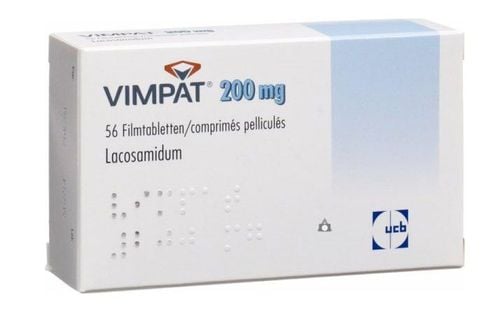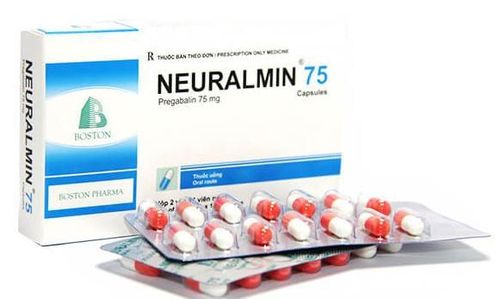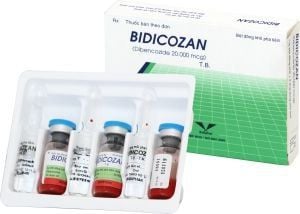This is an automatically translated article.
Gabex 400 is made in the form of hard capsules, with the main ingredient being Gabapentin. It is used in the treatment of neuropathic pain caused by the varicella zoster virus and epilepsy.
1. What is Gabex 400?
1 Gabex 400 tablet contains 400mg of Gabapentin plus other excipients. Gabapentin is an anticonvulsant. What does Gabex 400 do? The mechanism of the analgesic effect of Gabapentin is unknown, but in many experiments with neuropathic pain and pain in peripheral inflammation, this drug has been found to have a fairly good effect.
Indications to use Gabex 400 in the following cases:
Treatment of neuropathic pain caused by varicella zoster virus; Treatment of partial seizures with or without generalization in patients over 12 years of age; Adjunctive treatment of partial seizures in children 3-12 years of age. Gabex 400 is contraindicated in patients with a history of hypersensitivity to the active ingredients and components of the drug.
2. Usage and dosage of Gabex 400
2.1. Dosage Orally, with or without food. If the dose of Gabapentin is reduced or replaced with another drug, it should be done gradually over a minimum of 1 week, possibly longer as directed by the doctor.
2.2. Dosage for neuropathic pain due to varicella zoster virus: Adults can start taking gabapentin at a dose of 300mg on the first day, 600mg on the second day (in 2 divided doses) and 900mg on the 3rd day (in 3 divided doses). Subsequent dosing will be determined according to the need for pain relief until the dose reaches 1800 - 3600 mg/day.
Epilepsy:
Patients over 12 years old: The effective dose of Gabapentin is 900 - 1800mg/day, divided into 3 times/day, using 300mg or 400mg capsules. The starting dose is 300mg/time x 3 times/day. If necessary, the dose may be increased 3 times/day up to 1800 mg/day. In clinical studies, doses up to 2400 mg/day were well tolerated. Some patients have also taken doses up to 3600 mg/day for a short period of time and tolerated it well. The maximum time between doses of the drug should not exceed 12 hours; Children 3 - 12 years: Initial dose in the range of 10 - 15 mg/kg/day in 3 divided doses, reaching an effective dose determined by age in 3 days. The effective dose of gabapentin in pediatric patients 3 to 4 years of age is 40 mg/kg/day; Children 5 years and older is 25-35mg/kg/day, divided into 3 times/day. In a clinical study, doses up to 50 mg/kg/day were still well tolerated. The maximum time between doses should not exceed 12 hours. It is not necessary to monitor Gabapentin plasma concentrations to optimize treatment. In addition, because there are no significant interactions between gabapentin and other commonly used antiepileptic drugs, increasing the dose of gabapentin does not alter plasma concentrations of these drugs. If gabapentin is discontinued or an alternative antiepileptic drug is added, it should be done gradually over a minimum of 1 week.
Patients with renal failure: Adjust dosage for patients over 12 years old with impaired renal function or on dialysis as follows: Clcr > 60ml/min: Use dose 900-3600mg/day; Clcr 30 - 59ml/min: Dosage 400 - 1400mg/day; Clcr 15 - 29 ml/min: Dose 200 - 700mg/day; Clcr < 15ml/min: Use dose of 100-300mg/day. Dosage should be reduced in proportion to creatinine clearance. For example, a patient with Clcr 7.5ml/min should take a dose equal to 1/2 the daily dose of someone with a Clcr 15ml/min; Hemodialysis: Administer maintenance dose based on predicted creatinine clearance; take an additional dose orally every 4 hours of dialysis as prescribed by your doctor; Elderly: Since the elderly are more likely to have impaired renal function, dosing should be carefully selected, adjusted based on creatinine clearance in these patients. Overdose: There have been reports of acute oral overdose of Gabapentin up to 49 g. In these cases, the patient may experience double vision, slurred speech, drowsiness, dizziness, lethargy, and diarrhea. All patients recovered with supportive care. Alternatively, Gabapentin can be removed by dialysis (which may be indicated according to the patient's clinical condition or in patients with significant renal impairment).
3. Gabex 400 . side effects
Some side effects patients may experience when using Gabex 400 include:
3.1. Side effects when treating neuropathic pain caused by varicella zoster virus Systemic: Asthenia, headache, infection, abdominal pain, unexpected lesions; Gastrointestinal: Dry mouth, diarrhea, constipation, flatulence, nausea, vomiting; Nutrition and metabolism: Peripheral edema, hyperglycemia, weight gain; Nervous: Dizziness, dizziness, drowsiness, abnormal thinking, ataxia, abnormal clumsiness, forgetfulness, lack of coordination, decreased sensation; Respiratory: Pharyngitis; Skin and Appendages: Rash; Senses: Conjunctivitis, decreased vision, diplopia, otitis media; Other reactions: Indigestion, dyspnea, back pain, neuralgia, pain, shivering, flu syndrome. 3.2. Side effects when treating epilepsy Systemic: Weight gain, fatigue, back pain, peripheral edema; Cardiovascular: Vasodilation; Digestive: Dry mouth, indigestion, dry throat, constipation, increased appetite, abnormal teeth; Blood and lymphatic system: Thrombocytopenia; Musculoskeletal: Muscle pain, fracture; Nervous: Dizziness, drowsiness, nystagmus, ataxia, restlessness, tremors, dysarthria, anxiety, forgetfulness, abnormal thinking, lack of coordination, irritability; Respiratory: Cough, rhinitis, pharyngitis; Skin and appendages: Skin itching, skin abrasions; Genital: Impotence; Experimental results: Decrease in white blood cell count.; Other reactions in people over 12 years old: Headache, viral infection, nausea, vomiting, fever, abdominal pain, diarrhea, confusion, convulsions, insomnia, rash, rash, irritability; Other reactions in children 3-12 years: Viral infection, weight gain, fatigue, fever, nausea or vomiting, somnolence, emotional lability, hostility, hyperactivity, dizziness, dizziness, pneumonia management, respiratory tract infection, sore throat, headache, rhinitis, convulsions, diarrhea, loss of appetite, otitis media, cough, etc. Patients should inform their doctor about any side effects. encountered while using Gabex 400 for timely and effective treatment.
4. Be careful when using Gabex 400
Some notes for patients to remember before and while taking Gabex 400:
Use caution when using the drug in patients with a history of mental illness. If some unusual signs of mental illness occur, the use of Gabapentin should be discontinued or the dose reduced; Gabex 400 should be used with caution in patients with renal impairment. Dosage should be reduced in patients with impaired renal function or on hemodialysis; Gabapentin can be used with other antiepileptic drugs without regard to changes in the blood levels of Gabapentin or other antiepileptic drugs because monitoring of these parameters is not necessary; Gabapentin can cause dizziness, lightheadedness, drowsiness and depression of the central nervous system, so users of Gabex 400 should not drive or operate complex machinery until they can do these things safely. safe way; There are no appropriate studies on the use of Gabex 400 in pregnant and nursing women. Therefore, only use the drug in this group of people after the doctor has carefully weighed the benefits and risks; The safety and efficacy of gabapentin use in the treatment of neuropathic pain caused by the varicella zoster virus in children have not been established. In addition, the effectiveness of treatment of partial seizures with Gabex 400 has not been determined in children under 3 years of age; Gabapentin dosing should be carefully selected in elderly patients. It is recommended to start with the lowest dose in the dose range because patients often have impaired liver, kidney, heart and other diseases. Gabex is significantly excreted by the kidneys, so there is a risk of toxic reactions in patients with renal impairment. Therefore, elderly patients are more likely to have renal impairment and care should be taken when choosing the dose.
5. Gabex 400 . drug interactions
Some drug interactions of Gabex 400 include:
Concomitant use of Naproxen sodium capsules with Gabapentin may increase the amount of Gabapentin absorbed by 12 - 15%. Meanwhile, Gabapentin did not affect the pharmacokinetic parameters of Naproxen; When Gabapentin and Hydrocodone were co-administered, the Cmax and AUC values of Hydrocodone were reduced compared to when Hydrocodone was used alone. Hydrocodone also increased Gabapentin's AUC by 14%; Patients receiving concomitant treatment of Gabapentin with Morphine may experience increased concentrations of Gabapentin. Signs of CNS depression (such as somnolence) should be carefully observed and the dose of Gabapentin or Morphine should be reduced, respectively; Cimetidine reduces changes in renal excretion of gabapentin and creatinine. However, this condition is of no clinical significance; Aluminum and magnesium antacids reduce the bioavailability of Gabapentin by about 0%. This decrease in bioavailability is only about 5% if Gabapentin is taken 2 hours after taking the antacids. Therefore, Gabapentin should be taken at least 2 hours after taking an antacid; Gabapentin has no interactions with oral contraceptives and Probenecid; Gabapentin may affect the results of urine protein tests (if using Ames N-Multistix SG test strips). When using Gabex 400, patients should inform their doctor in detail about the drugs they are taking, the diseases they have/are suffering from, so that they can make appropriate adjustments and avoid drug interactions. At the same time, patients should not arbitrarily stop taking or change the dose of the drug without the permission of the doctor to avoid adverse reactions or may cause the treatment results to be unsatisfactory.
Please dial HOTLINE for more information or register for an appointment HERE. Download MyVinmec app to make appointments faster and to manage your bookings easily.













